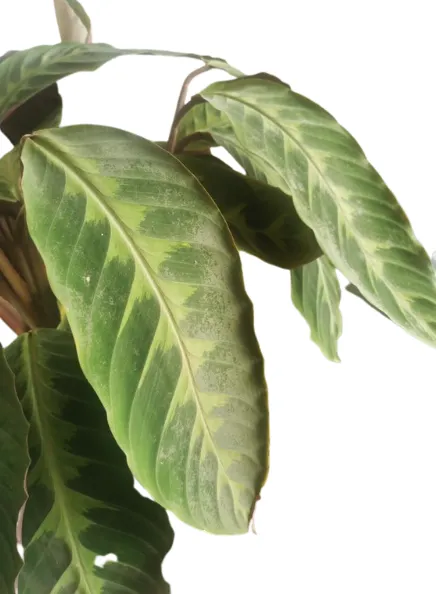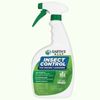Jungle Velvet Calathea belongs to the Calathea species and is botanically known as Calathea Warscewiczii. It is a flowering tropical plant recognized for its prominent, velvety two-toned leaves. The top of the leaf is dark and light green, making a fish-tailed pattern, whereas the lower side is maroon or burgundy. The plant is a perennial house plant migrated from tropical jungles of central and south America. It booms indoors with minimal but regular care. Calathea Warscewiczii’s plant care basic requirements are indirect bright light, warm temperatures, and high humidity.
Calathea Jungle Velvet adds tropical greenery indoors, growing up to 3-4 feet high in ideal surroundings, and it blooms with cream color ice-cream cone-shaped flowers in season. Its flowers are delicate and look like long white rose flowers with their petals overlapping and twisting, resembling a rose.
Popular Family Members: Calathea Medallion, Calathea Zebrina, Calathea Rufibarba, Calathea Ornata, Calathea Orbifolia, Rattlesnake Plant
Essential Products:
How to care for Calathea Warscewiczii?
The origin of Warscewiczii is South and Central America, where the climate is warm, humid, and wet because of heavy rainfall throughout the year. They dominantly flourish under shaded and humid areas with 65-85° F temperatures.
Calathea genre is infamous because of its high humid and indirect sunlight requirements. Unfortunately, the indoor home surrounding is not similar to the native natural environment. However, follow this care guide to keep this tropical sensation healthy and lush green in your home. It tells when to water, the soil requirements, fertilizing, how to repot and propagate to reward yourself with Calathea exceptional growth.

Initial Care of White Calathea
Houseplants are occasionally vulnerable to pests and diseases. It is vital to closely look at any new addition to your houseplant collection because an infected plant can spread contamination and diseases to your healthy indoor plants.
To avoid this, observe your new Calathea Warscewiczii plant closely. There could be chances of underlying infestation hiding in the dense foliage of the plants. Please make sure to particularly check the undersides of the leaves as spider mites make clusters of webs under the leaf.
If you buy the plant from a nursery, always pick the plant that looks fresh and healthy.
Beautiful Velvety Foliage of Jungle Plant
We recommend keeping the new plant isolated from your existing houseplant for a minimum period of two weeks.
Please keep inspecting the plant every three to four days for any sign of pests and diseases. If everything looks fine after two weeks and there is no sign of an infestation, place the plant at its final location along with other houseplants.

Does Jungle Velvet Calathea Bloom?
Calathea Warscewiczii produces beautiful stunning flowers like Calathea Crocata if you maintain indoor conditions of temperature, humidity, and light, similar to a tropical rainforest environment.
Calatheas rarely bloom indoors. However, Calathea Warscewiczii may surprise you with flowers if grown in favorable conditions. Calathea Jungle Velvet produces a gorgeous cluster of creamy cone-like eye-catching floral displays. At first glance, it seems like a gorgeous white blossomed rose.
Initially, the color of the flower is creamy, but with age, it turns to light yellow with a pink tint.
Icecream cone shaped Flower of Calathea Warscewiczii

Humidity and Temperature
Calathea Warscewiczii flourishes in the temperature range of 65°F to 80°F. In winter, if the temperature drops below 60°F, it affects plants’ growth and health. Furthermore, Calathea Jungle Velvet cannot tolerate sudden variations in ambient temperature; therefore, cold and hot drafts may cause harm to the plant.
Although Calathea Jungle Velvet prefers 65-85ºF for growth, it can withstand up to 90ºF) if high humidity is present. You can grow Calathea Jungle outdoor in U.S.D.A. zone 10 to 12.
The plant naturally goes into the dormancy period and stops growing below 60ºF. Cold drafts damage the leaves of Jungle Calathea. Therefore, please make sure that the plant is not exposed to cold air conditioning draft in summer, whereas in the winter season, protect the plant from chill coming in through windows. Similarly, keep them away from heaters or heating ducts in winters to avoid temperature variations.
Jungle Velvet Calathea humidity requirement is between 50 – 60 %. Perfect temperature and humidity levels boost the plants’ growth and health enormously. Plant humidifiers can create perfect humidity levels to duplicate their native tropical rainforest environment.
One more option is a homemade humidifier using a tray, stones, and water. To make this humidifier put stones in the tray and fill the tray up to the lower surface of stones. Keep the pot on those stones. Don’t let water touch the pot bottom in the tray.
Is misting well for Jungle Velvet Calatheas leaves?
Misting can be helpful to some extent; however, its results are not as consistent and effective as compared to a humidifier. Always use filtered or distilled water for misting. After misting, wipe out the leaves properly; otherwise, they will leave watermarks on beautiful leaves.

Jungle Calathea soil requirements
Calathea jungle velvet adores well-drained, airy, and moist soil to grow. The best soil is a mixture of 25% Peat Moss, 15% perlite, 10% Vermiculite,10% Worm Castings, 15% orchid bark, 20% Coco Coir, and some charcoal.
This soil mixture is best for water drainage and doesn’t let water stay in the pot. Well-draining soil remains moist, while soil with poor draining quality becomes soggy and affects the growth of the roots. Prolonged exposure of roots to water in waterlogged soil causes rotting of roots.

Velvet Jungle Calathea Light Requirement
Jungle Calathea thrives in shady areas as they are native to the tropical rainforest of South America. They cannot tolerate direct sunlight. If you plan to grow Calathea Warscewiczii outdoors, plant them under the shade of the trees.
Indoors, the best place for Jungle Calathea is the window facing north. However, they can be placed in front of the east or west-facing window with curtains or blinds, avoiding direct exposure to intense sunlight.
Too dark or too bright areas both affect plant growth and health. If plant leaves start bleaching, becoming pale, and the bright green color is fading, immediately change the Calathea spot to an area where low diffused sunlight is present. Moreover, the high intensity of the light may cause leaf curling, and the leaves start looking like maroon tubes.

Watering Requirement for Calathea Warscewiczii
Calathea Warscewiczii likes to grow in moist soil. Regular watering is required to keep the soil moist. High temperatures dry out the soil quickly; therefore, water your Calathea Jungle Velvet two to three times a week when the weather is warm.
Please follow the more frequent watering routine in the growing season from spring to late summer; however, in the winter season, watering once a week will be enough for plants requirements. Please be informed evaporation rate of water depends on several aspects like soil quality, pot material, and indoor climatic conditions.
Therefore, we recommend feeling the soil’s moisture level before rewatering the plant. The top one inch of soil shall feel dry before watering. Watering can also be monitored by a watering globe that controls water flow, keeps the soil moist, and protects it from overwatering.
Overwatering can cause root rot of Calathea and may lead the plant to death. Therefore, take all necessary action to avoid this situation. Always use pots with an appropriate drainage hole for your Calathea Jungle Velvet to allow the water to flow easily out from the soil.
Rainwater is the best option for watering the jungle velvet, but you may use filtered or distilled water if it’s not possible. Tap water contains many chemicals, and Calathea is sensitive to those chemicals and can develop crisp brown edges on leaves.

Fertilizing the Jungle Velvet Calathea
Jungle Velvet Calathea needs periodic fertilizing of the soil in the growing season. To retain plants’ nutrients, use diluted nitrogen-based or house plant fertilizers every month in the growing season. Organic fertilizer can also boost plant growth.
Dilute the fertilizer solution strength to prevent nutrients burning. Please do not fertilize the Calathea Warscewiczii more frequently, as the plant is sensitive to high minerals in the soil.
Minerals can accumulate in the soil over time and are not favorable for the plant. To avoid the situation, you may carry out soil flushing after two to three months.
To carry out the flushing, place the plant under a stream of water for two to three minutes and let water flow through the soil. As the water passes through the soil, it washes away the built-up minerals along with it. Once flushing is over, do not forget to drain the excess water completely.

How do I prune Calathea Warscewiczii?
Plants get injuries and get affected by diseases and natural factors. Naturally, they heal and sprout again after removing the affected plant leaf or branch. Pruning is a planned process of removing any leaf, branch, root, shoot twigs, or limbs.
Pruning is essential for maintaining plant health and shape. When you prune the Calathea Warscewiczii, it not only enhances its appearance but also initiates growth of new leaves. Prune all dead, yellow, brown, or decaying leaves with the help of clean shears or a sharp knife.

Is Calathea Warscewiczii pet friendly?
Calathea species leaves are so attractive not only for humans but also for pets. Kids and pets may want to play with the velvety soft leaves of Velvet Jungle Calathea. However, you shall not worry about it as the Calathea Warscewiczii plant is entirely non-toxic and poses no threat to pets and kids.

Propagation of Calathea Jungle Plant
Propagation increases your plant numbers and adds more greenery to your indoors. Calathea Jungle Velvet is a seed-producing flowering plant; however, its rhizomes are the most successful way to propagate it. In this propagation method, wait for new shoots to appear from the potting soil instead of taking a direct cutting from the plant. The new baby shoots usually arise along with the mother plant and consist of stem and rhizome.
Please follow the following steps to propagate Calathea Warscewiczii via rhizomes.
One other way to propagate Velvet Jungle Calathea is through seeds. It’s challenging but possible.

When Should I repot My New Calathea Warscewiczii?
Repotting is required once in two to three years. Calathea jungle plant takes time to adjust to new surroundings that’s why repotting every year is not suitable for the plant. After two years, if roots start coming out from the pot’s drainage hole or emerging from the topsoil, it’s time to repot the Calathea in a 2-inch bigger pot than before.

Jungle Velvet Calathea Pests and Problems
Red Spider Mite
A few alarming signs of pests are
Initially, the first sign will be Bronze or small yellow spot-on levees of the plant. If the plant suffers from red spider mites’ infection, then growth will stop, and the plant will turn into entirely yellow leaves.
Jungle Velvet Calathea can be recovered from spider might if a few leaves are infected. Spider mites suck sap from the leaves, and the plant gets deprived of the essential nutrients required for growth. Remove the highly infected parts and apply neem oil on the remaining infected leaves. However, If the whole plant leaves are significantly damaged, then it’s not possible to reverse the damage.
Common Problems
Calathea poor growth and Crispy brown leaf edges
Calathea velvet jungle plant native to South America where warm temperature and high humidity are present. They require a high level of humidity for healthy growth, and low humidity results in crispy brown edges of the leaves. Remove the brown leaves and improve the surrounding of your plant with the required humidity.
Brown spotting and curling of leaves
These symptoms appear only when the plant is dehydrated. Curling is a natural process to reduce transpiration through leaves curling to minimize the exposure of leaf surface to heat or light. They are native to Brazil with heavy rainfall; that’s why they require moist soil all the time, whereas dry soil will lead to the curling of leaves and brown spotting.

Brown spots on leaf
Excess amounts of minerals in soil or overfertilizing can also cause leaves’ edges to brown. To overcome this problem, water the plant and flush the soil to remove excess minerals from the soil. Browning tips are not a reversible process; only removing the leaves from the plant is the solution.
Wilted, drooping leaves or rotting stems
A rotting stem indicates overwatering of a plant or soil is waterlogged. To overcome this problem, shift the plant to moist soil or improve the drainage system of the pot. Reasons for wilted and drooping leaves can be exposure of the plant to too cold or hot currents.
Plants affected by cold drafts cannot be recovered if unfavorable conditions are prolonged. Move the plant as soon as possible to a warmer place.
Leaf pattern fading / washed out appearance
Two possible reasons could be.
High-intensity light bleaches the leaf and fades the bright green color, and they look dull.
Find a permanent spot in a shady area where direct exposure to the sun is avoided.

Fading of lush green color

Is Calathea Warscewiczii a prayer plant?
Calathea Warscewiczii species belong to the Geoppertia genus and the Marantaceae family. Maranta genus is also a part of Marantaceae and includes plants commonly referred to as prayer plants because their leaves respond day and night by curling as they are praying.
The Red-veined plant is one famous Maranta genus member and is commonly known as a prayer plant. The leaves of Calathea plants also respond to day and night changes; therefore, many people confuse them with prayer-plant and call them prayer plants. However, this is not true as Calathea Warscewiczii foliage doesn’t show praying hand movement and is not the actual prayer plant.
How big does the Calathea Warscewiczii plant grow?
Calathea Warscewiczii can grow up to 3-4 feet in height in a suitable environment. They are large indoor ornamental plants with beautiful velvety foliage.
Is Calathea Warscewizcii appropriate for beginners?
Calathea Warscewizcii plant care required more attention than some easy-going Calatheas like Leopardina and Freddie; therefore, it can be a problematic plant for beginners. However, the availability of care and guiding information can make it easy to grow this fussy plant.
It would be best to go through all the necessary information regarding the plant’s requirements before bringing the Calathea Jungle plant to your home.










